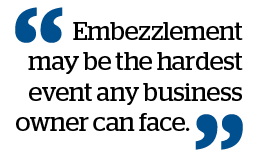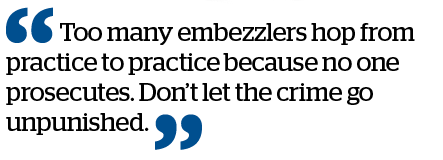Debra Phairas, President of Practice & Liability Consultants, LLC, discusses the best embezzlement prevention methods, red flags to look out for, and what to do if you suspect your staff are stealing from you.
Aesthetic practices are at high risk of embezzlement due to the cash nature of the business and desirability of fillers and products. Why physician practices? This may be due to the trusting nature of physicians, a lack of business training about separating duties in transactions involving money, or employees’ feeling overworked, underpaid, and/or underappreciated as well as the opportunity to get away with it. The potato chip analogy is common. Embezzlers cannot just stop with one chip, they keep nibbling once they start.
Embezzlement may be the hardest event any business owner can face. Sympathy abounds when a business suffers a fire, natural disaster or the death of a partner. Being stolen from by someone you’ve trusted leaves you feeling betrayed and gullible. Victims of embezzlement often say things such as ‘I feel like the newest member of the deceived club,’ ‘But we trusted her completely’ or ‘She/He was like a family member.’ I feel like I have been kicked in the gut.’
The best protection against embezzlement is prevention
It’s important that employees are valued and make sure they know it. Here are some basic guidelines:
- Pay competitive wage levels for your area. Survey local offices yearly or know your specialty wage to collection benchmarks
- Provide usual and customary benefits for your locale. Employers who pay and provide benefits comparable to area norms may be less likely to have employees feel they deserve more than they’re getting and will be less like to ‘help themselves’
- Show appreciation with sincere compliments; surprise treats such as lattes or ice cream, or schedule parties or team-building events that include both physicians and staff. These types of efforts help create a sense of belonging and loyalty to the practice and thus deter company theft.
Have policies and procedures in place

Inventory control
It is recommended to utilize software that has inventory control to reduce theft by employees. An EXCEL spreadsheet system can also be used if the practice does not have software. If the practice also includes a surgery center with narcotics or controlled drugs, a double lock system should be in place. This requires two employees at the same time who must unlock the cabinet, log out drugs and both sign to witness each other.
Videotaping
Employers may videotape with camera surveillance to prevent theft or other bad behavior in the workplace. This also has the benefit of reducing theft from patients as well. Videotaping increases safety to both employees and patients and promotes good behavior and preserves crime evidence.

Employers must let staff know why and where they use video and notify all employees in writing that video surveillance is conducted. Staff should sign a document saying they know they may be monitored.
Screen employees carefully
Perform a background check on all potential employees, and be sure the following are part of your screening and hiring process:
- Ask references if employee was ever convicted of embezzlement
- Include the same question on your application form; that way, you have clear grounds for dismissal if the employee lied
- In interviews, ask if the applicant is bondable, and clearly state that you will perform a background check
- Perform a credit check and a criminal-record check on all employees who will handle money.
Red flags
Pay attention to the following signs — they may signal a potential embezzlement issue:
- An employee does not take vacations, or does but insists that no one else handle billing or bookkeeping while they are away
- Employee takes billing or bookkeeping home
- Employee works long hours without complaint
- Employee works odd hours: early mornings and/or late evenings
- Employee’s lifestyle changes with an expensive car, jewelry, clothes, or vacations
- Employee talks about stress, family pressures, and financial problems
- Employee behaves defensively when bookkeeping or billing is discussed
- Employee suddenly volunteers to take on bookkeeping or billing
- Employee quits suddenly, particularly when a Certified Public Accountant (CPA) or consultant comes into the practice
- Office morale suddenly changes
- Patients or vendors complain about billing or bookkeeping errors
- Vendors send past-due bills
- Revenues drop or remain flat when an increase is expected
- Expenses in one category increase or total overhead goes up
- Checkbook is not current or does not balance
- Credit refunds increase
- Petty cash checks are cut more frequently; i.e., funds are being spent more rapidly and need to be replaced.
Accounting control
Many physicians do not learn the basic principles of accounting control. As a result, it is too easy for staff to take money. Do not expect your CPA to catch embezzlement unless you have specifically requested that office systems be set up to prevent it. It is the owner’s responsibility, since it’s the owner who will suffer.
Most embezzlement in medical practices is carried out by someone working alone, so the two key principles are:
- No one person should have control over the entire cash transaction process
- Duties involving money should be distributed to two or more people.
- That way, collusion would be required for embezzlement to occur, which is less likely.
For example, the same staff person should not open the mail, record the checks, balance out at the end of the day, post the payment, make the bank deposit and reconcile the bank statement. Even in a small office, these tasks can be given to two or more staff members. As a further safeguard, rotate the job of opening the mail.
Other precautions you can take include these:
- Have the bank statement go to your house, or if it comes to the practice, require it to be placed on your desk unopened
- Have an outside bookkeeper, CPA or someone else reconcile the bank statement
- Review electronic transfers carefully, and do not let anyone have access to online banking except a physician partner so that staff cannot transfer funds to a personal account
- Think carefully about allowing anyone except a physician partner to have the authority to sign cheques. Most groups also require two signatures on any cheques over a given amount, even when all signers are partners
- Perform unannounced random spot checks by matching the daily scheduled patients against posting and deposit slips. Many computer programmes have a ‘missing encounter’ feature that will perform this function. It is advisable to look into this functionality when choosing new software
- Monitor the level of cash payments; if it drops dramatically, this may be a warning sign. Receipts for cash should be sequentially numbered and have carbon copies
- Cheques should be stamped ‘For deposit only.’ You may want to have a physician make deposits, have the bank pick them up and/or use a lock box for cheques that go directly to the bank. Explanation of benefits forms and cheque copies can be either be scanned and available via the Internet or sent to the practice or its billing service
- Accounts payable is another area of risk. The manager or bookkeeper should present all cheques for payment along with the corresponding vendor invoice, and the physician should verify that the vendor is authentic. Review cancelled cheques and credit card statements the same way
- Do not allow staff to charge for items to the company credit card. Always review credit card statements. Don’t allow practice cheques to be written for personal items or allow employees to use your practice as a bank and write cheques for cash.
- Have an outside person double check the payroll. Managers are sometimes able to give themselves a ‘bonus’ or increase their own pay without the physician knowing because the bank statement only shows the total payroll amount debited, not the individual payroll amounts. You must double check payroll reports.
Too late for prevention? Consider prosecuting

Contact an attorney who, after determining that there is concrete evidence, will assist you in confronting the embezzler and will prepare a confession and a restitution agreement. If the thief is remorseful, a repayment plan can be worked out or you may be able to repossess assets or garnish wages. But don’t hesitate to send an embezzler to jail if it comes to that.
However, the adage ‘An ounce of prevention is worth a pound of cure’ is probably the best advice. Take steps to stop embezzlement before it starts.
Key points
- Prevent embezzlement by showing appreciation to staff
- Perform background checks on staff who handle money
- Implement Accounting Control. Separate transaction of cash duties, never let one person handle all aspects of opening mail, posting, balancing, making deposits and reconciling the bank statement.
- Implement inventory control procedures for fillers and products.
- Consider videotaping or camera surveillance
- Do not allow managers to sign checks or have access to on-line banking and lines of credit
- Be aware of ‘red flags’ which may indicate embezzlement
- Prosecute and try to obtain restitution.








